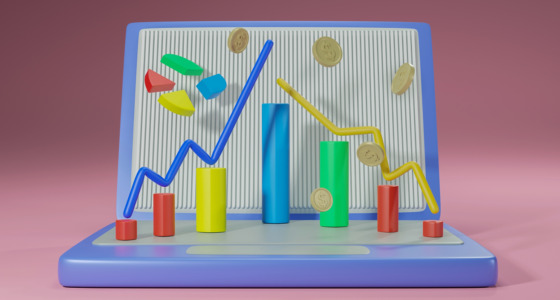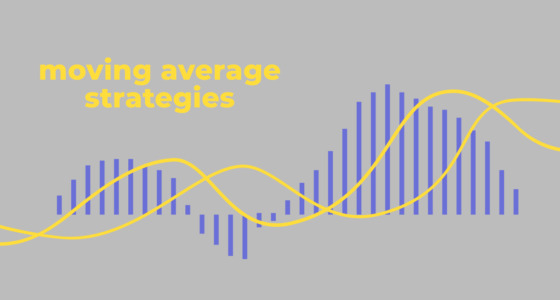

Breakout trading is a concept that allows traders to enter a trade at its early stages with a significant trading volume. Breakouts occur when market participants are strong enough to drive the price beyond solid support and resistance levels. Although the concept is simple, there are risks of fakeouts that may result in losses. Discover how to determine the price direction correctly.
Some websites provide information on stock breakouts. This is when a stock price breaks above or below a moving average. MarketBeat is an example of such a website with the most popular global stocks.
What is a breakout trade?
A breakout trade refers to opening a position when a price breaks above a solid resistance level or falls below a strong support level. As increased trading volumes accompany a breakout, a trader opens a position in the direction of a breakout.
Breakouts may signal a price reversal and a trend continuation. A significant advantage of breakouts is that they can occur and be solid on any timeframe.
Breakout trading term is used for both market conditions — when the price breaks above a resistance level and falls below a support one. However, sometimes you may see that a fall below a support line is called a breakdown. Still, there is no difference with the breakout concept.
How to trade breakouts and breakdowns
Breakouts are used to enter the market at early stages. Thus, as soon as the price rises above the resistance level, you should buy. When the price falls below the support level, you should sell.
To trade breakouts like a pro, you don’t need specific knowledge. It’s enough to look at a chart. Breakouts occur after the price trades within a narrow channel and touches either support or resistance level at least two times. As the price trades within a limited range for a considerable period, price volatility increases after the breakout occurs.
Another benefit of breakout trading is that you can easily define an exit point. Usually, the distance the price goes in a breakout direction equals the range within which the price was consolidating.
You only need to draw support and resistance levels to find a breakout. They can form a channel or be a part of a pattern.
Common breakout patterns
There are numerous patterns that involve a breakout. The most common examples are head and shoulders and inverted head and shoulders, double/triple top/bottom, wedges, flags, pennants, and triangles. Some of these patterns predict a trend continuation and some form ahead of a trend reversal. Let’s consider how to trade breakouts on the triangle pattern.
How to trade triangle breakouts
There are three types of triangle patterns. These are ascending, descending, and symmetrical.
- An ascending triangle is mostly formed in an uptrend and signals a continuation of the price rise. When the price breaks above the resistance level, it signals you can buy an asset. The potential target will equal the distance between early points of support and resistance levels.
- A descending triangle is mainly considered a bearish pattern. You can open a short position when the price falls below the support level. The take-profit target will equal the distance between early points of support and resistance levels.
- A symmetrical triangle can provide both bullish and bearish signals depending on the breakout direction. The target will equal the distance between early points of support and resistance levels.

How to trade a breakout: breakout and fakeout
It’s a common situation when a breakout turns into a fakeout.
A fakeout is when the price breaks a support or a resistance level, but market makers aren’t strong enough to drive it further. Therefore, the price turns around.
As breakouts occur on increased trading volume, you can use the volume indicator to confirm the market is strong enough to drive the price.
To close a losing trade, you need to place a stop-loss order near the breakout line. If the price breaks above a resistance line, it will turn to support. Therefore, a price return below this level will confirm a losing trade. If the price falls below the support level, it will become the resistance. Thus, if the price breaks above a new resistance, a losing trade is confirmed.
Tips for trading breakouts
Are you ready to trade breakouts? Here are some useful tips to make your activity pay off:
· Consider using options data – If you want to improve your timing, you might want to use options data. There are technical analysis pages where you can check lots of useful data in order to see which options have higher or lower volatility. In breakout trades, the Volatility Percentile figure should be over 70%.
· Always use volatility cycles to your advantage – There are periods of low and high volatility in any market. If you want to come up with a great strategy, you should pay attention to volatility cycles and use them to your advantage. This way, you can look out for trading ranges during times of low volatility, then enter breakouts when volatility is high.
· Look for breakout candidates to save time – If you want the trading process to be easier and quicker, you should look for breakout candidates. It’s possible to look for wedges, channels, and flags in chart patterns.
· Consider the trend direction – For successful trades, you should always trade breakouts in the trend’s direction. You should use two swing points so you can draw a resistance and support line along a trend, then follow it.
· Do false breakout trades – Over time, you will learn about trading false breakouts. Even if it seems risky, you’ll have no problems if you do it right. If you want to win with false breakouts, you should look for breakouts that fail quickly, go against the trend, and come from the formation of a minor price.
Second-chance breakout strategy
The second-chance breakout strategy is commonly used by traders in order to deal with the false breakout issue. The strategy involves a trader waiting for a legitimate breakout to appear. Then they enter a position only when the price moves and retest the initial breakout point.
It’s not that common for these retests to happen, though, which is why this strategy involves a long waiting time. Besides, traders don’t always have to wait for the precise breakout point.
Meanwhile, in the event of a retest of the original breakout point, the trader instantly gets another opportunity to trade on the movement. To decrease potential disadvantages, traders can use stop losses with this strategy.
So, by using this strategy, a trader can train to have more patience and wait for a precise breakout point instead of having to deal with the fakeout procession.
Analyze and anticipate for lower-risk trades
You do not have to wait for a breakout to trade when chart patterns and ranges happen in greater trends.
When an asset’s price is trading higher and eventually moves into a range, an upside breakout is more likely to happen instead of a downside one. So, you should purchase close to the bottom of the range and not wait for the upside breakout to happen.
If you do this, you have higher chances of making a profit in case the breakout turns out to be upside. This happens when you enter at a more convenient price compared to those who purchased at the breakout price. Also, you can always exit close to the top of the range to earn a decent profit, even when the price remains in the range.
You can decrease risk by putting your stop-loss right under your entry.
Focus on patterns not everyone will see
If you’re interested in trading breakouts in the usual way, you should focus on patterns such as pennants/triangles and not ranges. The good news is that it’s not difficult to notice ranges. Even new traders should be able to spot them.
For this reason, ranges are quite popular among traders.
Takeaway
Breakout trading is a popular concept that can be applied to any timeframe and financial instrument. It implies clear take-profit and stop-loss levels and allows trading in any market condition. Still, if you want to learn how to trade breakouts like a pro, you should practice a lot.









